
Incheon, formerly Jemulpo or Chemulp'o (제물포) until the period after 1910, officially the Incheon Metropolitan City, is a city located in northwestern South Korea, bordering Seoul and Gyeonggi to the east. Inhabited since the Neolithic, Incheon was home to just 4,700 people when it became an international port in 1883. Today, about 3 million people live in the city, making it South Korea's third-most-populous city after Seoul and Busan.

Incheon International Airport or simply Incheon Airport is the main international airport serving Seoul, the capital of South Korea. It is also one of the largest and busiest airports in the world.

The Gyeongui Line is a railway line between Seoul Station and Dorasan Station in Paju. Korail operates the Seoul Metropolitan Subway service between Seoul Station and Dorasan Station.
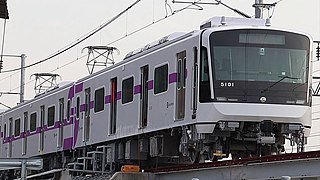
Seoul Subway Line 5 of the Seoul Metropolitan Subway, dubbed the purple line, is a long line crossing from west to the east across the Seoul National Capital Area, South Korea. It is one of two subway lines in Seoul to cross under the Han River, which is done at two points. The main line runs through to Hanam Geomdansan Station while the branch line from Gangdong Station terminates at Macheon Station. In 2019, Line 5 carried an annual ridership of 334 million or about 915,000 passengers per day.
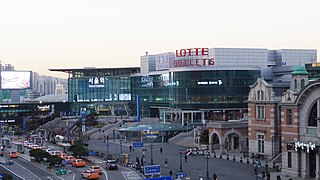
Seoul Station (Korean: 서울역) is a major railway station in Seoul, the capital of South Korea. The station is served by the Korail Intercity Lines and the commuter trains of the Seoul Metropolitan Subway.

Bucheon is a city in Gyeonggi Province, South Korea. Bucheon is located 25 kilometers (16 mi) away from Seoul, of which it is a satellite city. It is located between Incheon and Seoul.

FC Seoul is a South Korean professional football club based in Seoul that competes in the K League 1, the top flight of South Korean football. The club is owned by GS Sports, a subsidiary of GS Group. Since 2004, FC Seoul have played its home games at the Seoul World Cup Stadium in Seoul's Mapo District.
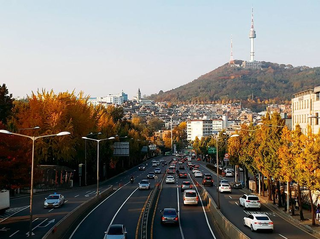
Yongsan District is one of the 25 districts of Seoul, South Korea.

Seoul Subway Line 4 of the Seoul Metropolitan Subway is a long line crossing from the southwest to the northeast across the Seoul National Capital Area. The central section in Seoul City is operated by Seoul Metro with some trains offering through service to Korail's Ansan and Gwacheon Lines. The southern terminus (Oido) is in Jeongwang 4-dong, Siheung City, and the northern terminus (Jinjeop) is in Jinjeop-eup, Namyangju-si, Gyeonggi-do; the newly built northern section is correspondingly owned by a company owned by Namyangju-si, with operations contracted to Seoul Metro. In 2022, the Seoul Metro operated section had an annual ridership of 219,587,000 or about 601,608 passengers per day.

AREX is a South Korean airport rail link and commuter rail line that links Incheon International Airport with Seoul Station via Gimpo International Airport.

Seocho District is one of the 25 local government districts which make up the city of Seoul, South Korea. Seocho is a part of the Gangnam region, along with the Gangnam district of Seoul. Seocho District ranks as one of the richest neighborhoods in South Korea and among the most expensive areas in Seoul with an average sales price of 47.75 million South Korean won per 3.3 square meters. Many of the wealthiest residents are concentrated in the three Gangnam districts including Seocho, known as Gangnam School District Eight.

Jung District is one of the 25 districts of Seoul, South Korea.
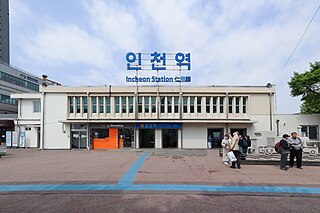
Incheon Station is the western terminus railway station of the Suin–Bundang and Gyeongin lines of the Seoul Metropolitan Subway. The station is in the Bukseong neighborhood of the Jung District in Incheon, South Korea and is approximately 20 kilometers west of Seoul. Established in 1899 under the Korean Empire as Chemulpo Station, Incheon Station is the oldest train station in the Seoul Capital Area. During the Japanese occupation of Korea, the station was briefly named Hainchon Station and the original station building was destroyed during the Korean War. Service for the old Suin Line began in 1937 and ended in 1995; the new Suin Line was extended to the station in 2016. Service for the Gyeongin Line began in 1974.

Seoul, the capital of South Korea, has been called by a number of formal and informal names over time. The word seoul was originally a common noun that simply meant "capital city", and was used colloquially to refer to the capital throughout Korean history. Seoul became the official name of the South Korean capital after its liberation from Japan after the Second World War.
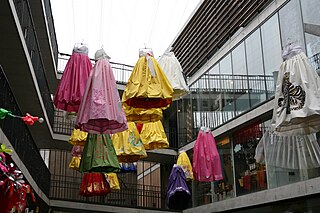
Seoul, the capital of South Korea, has many shopping areas and markets throughout the city. Famous ones include Myeong-dong, Cheongdam-dong, the Hongdae area, and the Dongdaemun and Namdaemun markets.
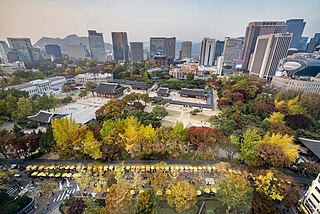
Seoul, officially Seoul Special City, is the capital and largest city of South Korea. The broader Seoul Capital Area, encompassing Gyeonggi province and Incheon metropolitan city, emerged as the world's fourth largest metropolitan economy in 2014, trailing only Tokyo, New York City, and Los Angeles, hosting more than half of South Korea's population. Although Seoul's population peaked at slightly over 10 million, it has gradually decreased since 2014, standing at approximately 9.97 million residents as of 2020. Seoul is the seat of the South Korean government.
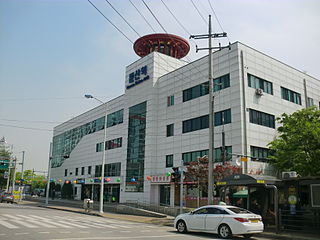
Munsan Station (Korean: 문산역) is a railway station on the Gyeongui–Jungang Line. It is notable for being the closest station on the Seoul Metropolitan Subway to the border with North Korea that is open for passenger service, only a few kilometers away.
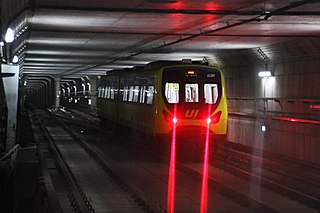
The Ui LRT, referred to as the Ui-Sinseol LRT or Ui-Sinseol Line (우이신설선) in Korean, is a light metro which is part of Seoul Metropolitan Subway. It is a fully underground 11.4 km (7.1 mi) Light Rapid Transit line from Ui-dong to Sinseol-dong in northern Seoul which opened on September 2, 2017. The line, which is expected to carry 110,000 passengers a day, has 13 stations. It connects to Line 4 at Sungshin Women's University, Line 6 at Bomun and Lines 1 & 2 at Sinseol-dong. The last (northernmost) station is in Ui-dong, hence the name of the line. In 2019, the line carried 27 million passengers or about 75,000 people per day.
High-speed rail service in South Korea began with the construction of a high-speed line from Seoul to Busan in 1992, and was inspired by Japan's Shinkansen. The first commercial high-speed rail service was launched on 1 April 2004. Currently, South Korea hosts two high-speed rail operators: Korea Train eXpress (KTX) and Super Rapid Train (SRT).

The Suseo–Pyeongtaek high-speed railway, also known as Suseo–Pyeongtaek HSR, is a high-speed rail line from Suseo station in southeast Seoul to a junction with the existing Gyeongbu high-speed railway in South Korea. The line was built to ensure southeast Seoul and southern Gyeonggi-do have high-speed rail connections.




















